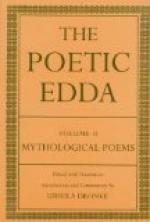Third Gudrun Lay, or the Ordeal of Gudrun (after her marriage to Atli), is romantic in character. The Gothic hero Thjodrek (Dietrich) is introduced.
Oddrun’s Lament, in which Gunnar’s death is caused by an intrigue with Atli’s sister Oddrun, marks the disintegration of the Volsung legend.
The two Atli Lays (Atlakvida and Atlamal, the latter of Greenland origin), deal with the death of Gunnar and Hoegni, and Gudrun’s vengeance on Atli.
Gudrun’s Lament and Hamthismal belong to the Ermanric cycle.
Volsung Paraphrases. (Page 11.)
Skaldskaparmal, Voelsunga Saga and Norna-Gests Thattr (containing another short paraphrase) are all included in Dr. Wilken’s Die Prosaische Edda (Paderborn, 1878). There is an English version of Voelsunga by Magnusson and Morris (London, 1870) and a German version of Voelsunga and Norna-Gest by Edzardi.
Nibelungenlied. (Page 11.)
Editions by Bartsch (Leipzig, 1895) and Zarncke (Halle, 1899); translation into modern German by Simrock.
Signy and Siggeir. (Page 13.)
Saxo Grammaticus (Book vii.) tells the story of a Signy, daughter of Sigar, whose lover Hagbard, after slaying her brothers, wins her favour. Sigar in vengeance had him strangled on a hill in view of Signy’s windows, and she set fire to her house that she might die simultaneously with her lover. The antiquity of part at least of this story is proved by the kenning “Hagbard’s collar” for halter, in a poem probably of the tenth century. On the other hand, a reference in Voelsunga Saga, that “Haki and Hagbard were great and famous men, yet Sigar carried off their sister, ... and they were slow to vengeance,” shows that there is confusion somewhere. It seems possible that Hagbard’s story has been contaminated with a distorted account of the Volsung Signy, civilised as usual by Saxo, with an effect of vulgarity absent from the primitive story.
In a recently published pamphlet by Mr. W.W. Lawrence and Dr. W.H. Schofield (The First Riddle of Cynewulf and Signy’s Lament. Baltimore: The Modern Language Association of America. 1902) it is suggested that the so-called First Riddle in the Exeter Book is in reality an Anglo-Saxon translation of a Norse “Complaint” spoken by the Volsung Signy. Evidence from metre and form is all in favour of this view, and the poem bears the interpretation without any straining of the meaning. Dr. Schofield’s second contention, that the poem thus interpreted is evidence for the theory of a British origin for the Eddie poems, is not equally convincing. The existence in Anglo-Saxon of a translation from the Norse is no proof that any of the Eddie poems, or even the original Norse “Signy’s Lament” postulated by Dr. Schofield, were composed in the West.
It seems unnecessary to suppose, with Dr. Schofield, an influence of British legend on the Volsung story. The points in which the story of Sigmund resembles that of Arthur and differs from that of Theseus prove nothing in the face of equally strong points of correspondence between Arthur and Theseus which are absent from the Volsung story.




